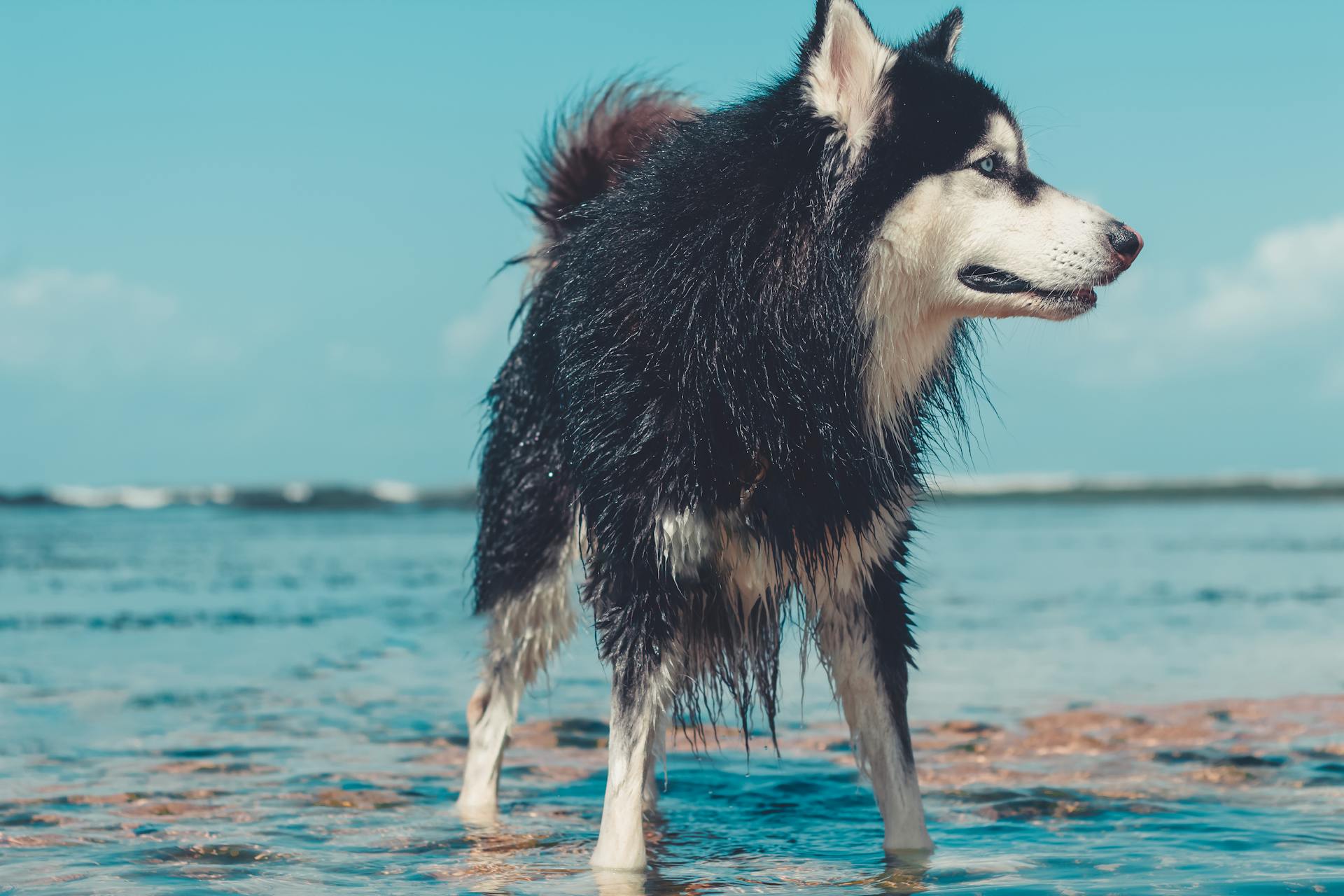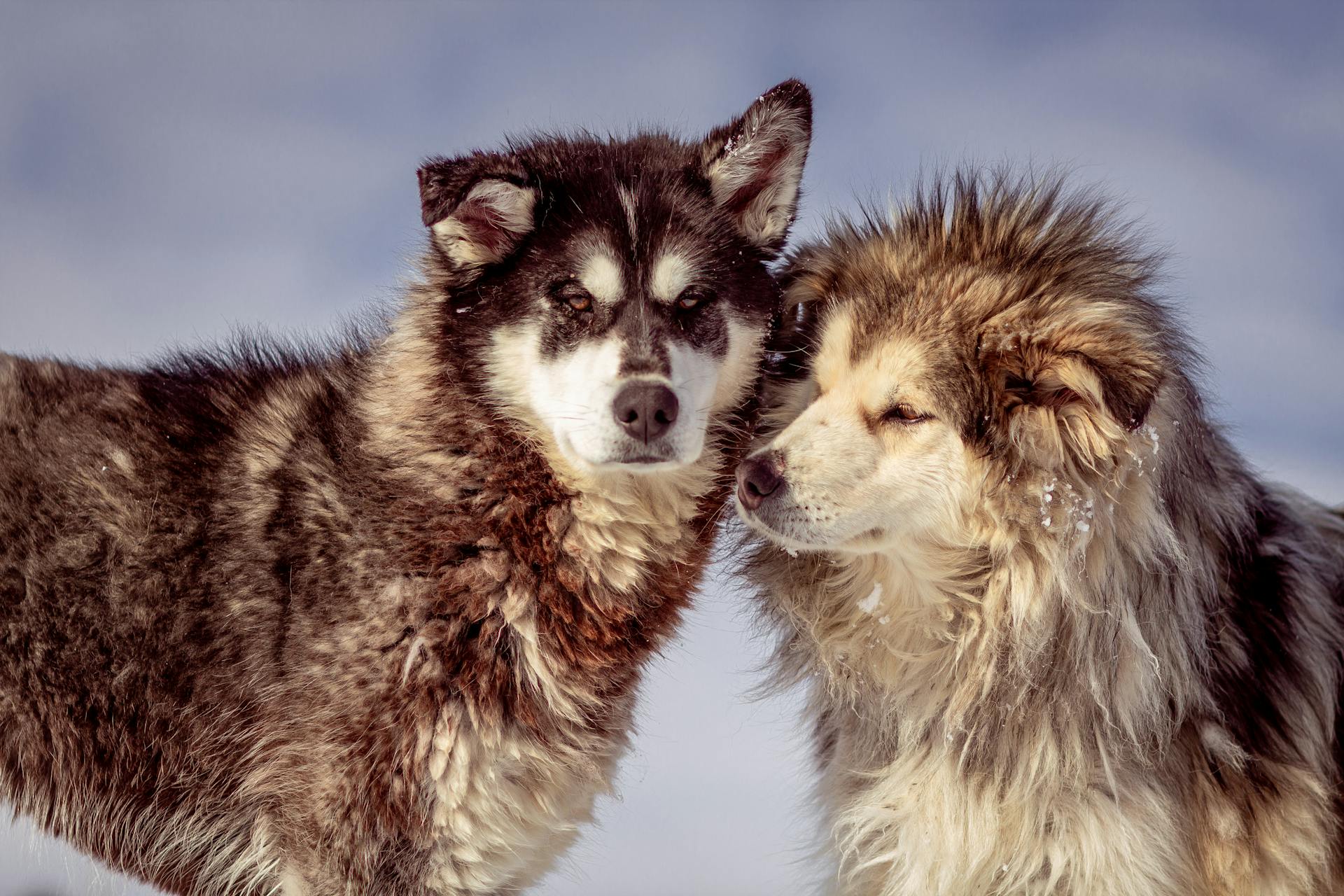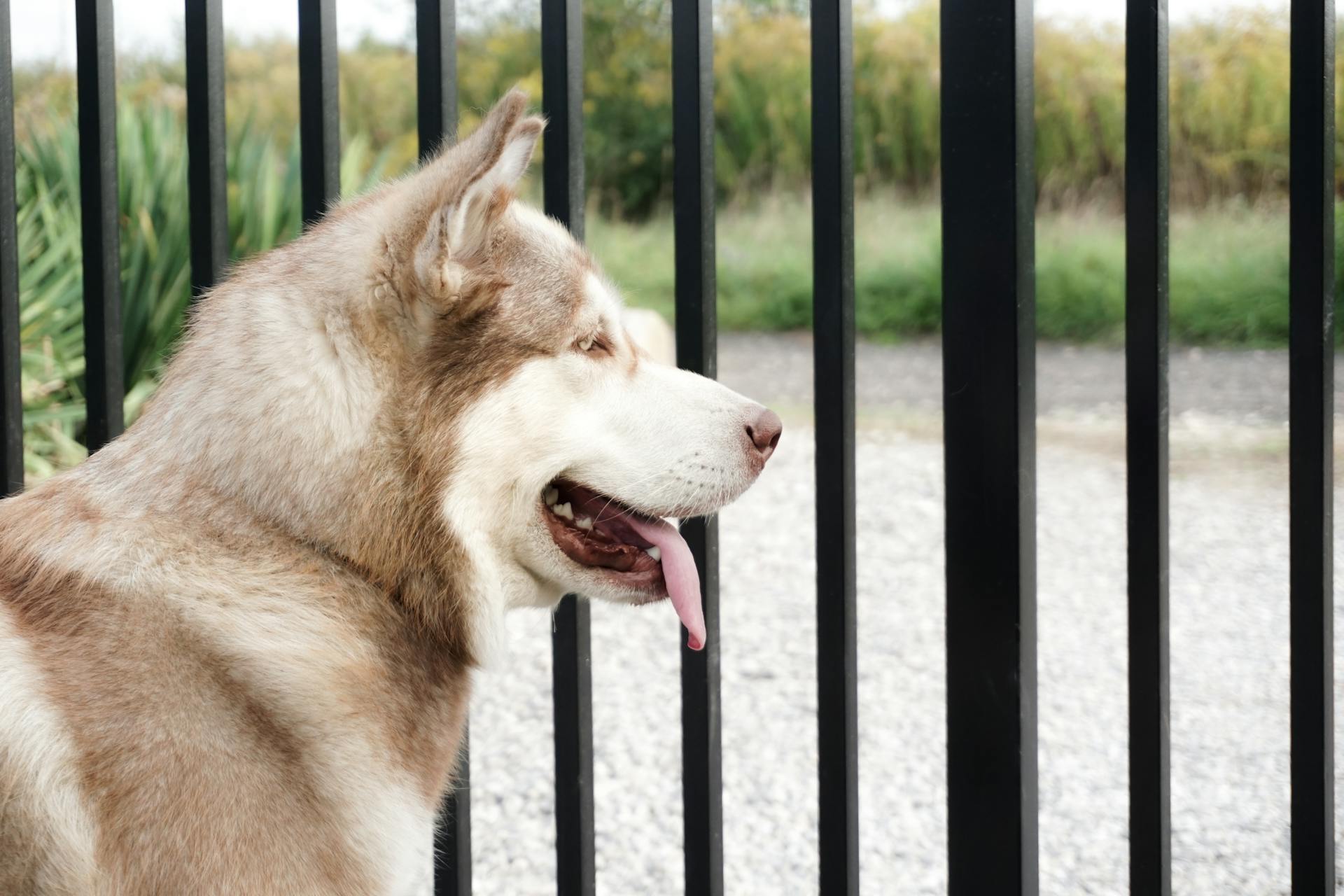
The Malamute sled dog is a breed with a rich history, originating from the Inuit people of Alaska and Canada. They were bred to pull heavy loads over long distances in harsh Arctic conditions.
Their ancestors were likely the Eskimo dogs, which were brought to the Americas by the Thule people. Malamutes were specifically bred for their strength, endurance, and ability to withstand extreme cold.
Malamutes have a distinctive appearance, with a thick double coat, a broad chest, and a muscular build. They typically weigh between 70-95 pounds and stand between 23-26 inches tall at the shoulder.
In their working performance, Malamutes are known for their incredible pulling power, with some individuals capable of hauling loads of up to 1,000 pounds.
Discover more: Are Alaskan Malamutes Good Guard Dogs
Physical Characteristics
The Alaskan Malamute is a large and powerful dog, with a sturdy build that's perfect for hauling heavy loads. Their thick double coat is a key feature, helping them withstand extreme cold temperatures.
Their broad head and expressive almond-shaped eyes give them an alert and intelligent look. Their erect ears are always perked up, as if listening for the next command.
The Alaskan Malamute's coat comes in a variety of colors, including shades of gray, black, and red. This distinctive wolf-like appearance is sure to turn heads wherever you go.
History and Origins
The Alaskan Malamute has a rich history that spans over 4,000 years, dating back to the native Inuit people of Alaska.
These dogs were bred to have the physical and mental characteristics necessary for their demanding lifestyle, helping the Inuit people hunt for food, transport supplies, and navigate the treacherous Arctic landscape.
The Alaskan Malamute's strength, endurance, and intelligence made them an essential part of the Inuit people's survival, and they thrived in their harsh environment.
In the early 20th century, Alaskan Malamutes gained recognition outside of Alaska, showcasing their strength and endurance in various expeditions to the Arctic and Antarctic regions.
Here's an interesting read: Inuit Sled Dogs
Alaskan
The Alaskan Husky is a breed developed specifically for dog sledding, weighing between 18 and 34 kg and having dense or sleek fur.
These dogs have a rich history, with the first Alaskan Husky ancestors arriving in the Americas 12,000 years ago and establishing in the Arctic 4,500 years later.
The Alaskan Husky is a mix of different inuit and polar dogs, hunting dogs, and possibly others, making it a unique breed.
This breed is well-suited for hard work and can handle great variations in weather and temperature, making it a valuable asset for mushers.
In contrast, the Alaskan Malamute is a large, strong freight-type dog, weighing between 36 and 54 kg and having a broad chest and thick coat.
The Alaskan Malamute was actually one of the first ever domesticated breeds of dogs, originating from Alaska and known for their pulling strength.
The Siberian Husky, on the other hand, is a breed that can pull heavier loads than the Malamute, but is not as persevering, weighing between 18 and 27 kg.
This breed has been selectively bred for both its looks and its ability to pull heavy loads, making it a popular choice for dog sledding.
Canadian Eskimo Dog
The Canadian Eskimo Dog has its origins in the aboriginal sled dogs used by the Thule people of Arctic Canada.
This breed has a rich history, and its development is a testament to the ingenuity of the people who bred them. The Canadian government was responsible for breeding the modern Canadian Eskimo Dog.
These dogs were bred to be incredibly strong, capable of pulling between 45 and 80 kilograms per dog for distances between 24 and 113 kilometres.
Consider reading: Canadian Inuit Dog
Greenland Dog
The Greenland Dog is an impressive breed, known for its great endurance but limited speed. They're originally from Greenland and have been used for centuries as a mode of transportation.
In fact, in several regions on Greenland, they're still the primary mode of transportation during the winter. This is largely due to their reliability and the fact that they're more dependable than snowmobiles.
As of 2016, there were about 15,000 Greenland Dogs living in Greenland, but their population has declined significantly over the years.
You might enjoy: Huskies in Greenland
History

The Alaskan Malamute's history is deeply rooted in the lives of the native Inuit people of Alaska, who relied on these dogs for survival. They helped with hunting, transporting supplies, and navigating the treacherous Arctic landscape.
The breed dates back over 4,000 years, making it one of the oldest Arctic sled dog breeds. These dogs were bred to have the physical and mental characteristics necessary for their demanding lifestyle.
Alaskan Malamutes were not only capable of pulling heavy loads for long distances but were also friendly and affectionate, making them excellent family dogs.
You might enjoy: Arctic Alaskan Malamute
Alaska's Near Extinction
The Alaskan Malamute nearly went extinct in the late 19th century due to the breeding of sled dogs with other breeds to meet the high demand for working dogs during the Gold Rush.
This mixed breeding had a devastating effect on many sled dog breeds, but fortunately, the isolation of the Mahelemut people saved the Alaskan Malamute from extinction.
Their dogs remained untouched by this mixed breeding, preserving the breed's purity and unique characteristics.
The Mahelemut people's isolation played a crucial role in saving the Alaskan Malamute from extinction, highlighting the importance of preserving traditional breeding practices.
Here's an interesting read: Best Dogs for Dog Sledding
Working and Performance
Alaskan Malamutes were developed as sled dogs, but they were also used for hunting and guardianship.
Their versatility in the Arctic made them a valuable asset to their humans, who were at risk of bear attacks.
In addition to pulling sleds, Malamutes were tasked with protection duties, helping to safeguard their families and communities.
Their strong instincts and loyal nature made them well-suited for this role, and they proved to be effective guardians.
The Malamute's ability to perform a variety of jobs has made them a beloved breed among outdoor enthusiasts and working dog owners alike.
Readers also liked: Do Alaskan Malamutes Shed
Care and Management
Alaskan Malamutes need a daily dose of exercise, so make sure to take them on a long walk or hike every day, and engage them in vigorous games to keep them happy and healthy.
Their thick coat requires daily brushing, especially during shedding season, to prevent matting and tangling.
To prevent overheating, Malamutes prefer cold climates and need to be monitored in warm weather.
As with any large breed, hip dysplasia is a concern, so it's essential to feed your Malamute puppy a large-breed puppy food that slows their growth rate.
Their sensitive eyes can be prone to day blindness, making them sensitive to bright light, and cataracts are also a possible issue, so regular eye checks are a must.
A fresh viewpoint: Cute Alaskan Malamute Puppy
Exercise
Alaskan Malamutes need at least 1 to 2 hours of exercise every day to burn off their energy and stay happy and healthy.
They thrive on physical activity and mental stimulation, so regular exercise is a must. Providing them with long walks, jogging, hiking, or participating in dog sports like agility or obedience can keep them engaged and exercised.
Alaskan Malamutes also enjoy pulling or carting activities, so if you have the space and resources, consider getting a sled or cart for them to pull.
They're not well-suited for apartment living and need a large, securely fenced yard to roam and explore. Without proper exercise and mental stimulation, they can become bored and exhibit destructive behaviors.
Care and Upkeep
Alaskan Malamutes need a daily long walk or hike, coupled with vigorous games to keep them happy and healthy.
They require a safe or securely fenced space to run, as they can be escape artists and don't always come when called.
Their thick coat needs daily brushing, especially during shedding season.
In warm weather, their dense coat can cause overheating, so it's essential to keep them cool.
As they age, Alaskan Malamutes can experience day blindness, making them sensitive to bright light.
They're also prone to cataracts and an underactive thyroid, so regular check-ups with a veterinarian are crucial.
To prevent hip dysplasia, feed your puppy a large-breed puppy food that slows their growth rate.
Intriguing read: Fat Malamute Puppy
Temperament and Intelligence
The Alaskan Malamute is a strong-willed breed that requires consistent training and socialization to thrive.
They are highly intelligent and hardworking dogs that are often described as friendly and loving when socialized properly.
Their independent nature and occasional stubbornness can make training challenging, but they learn quickly for sledding or pulling.
Consider reading: Malamute Training
Malamutes are moderately energetic and playful, with a sense of humor that can sometimes get them into mischief.
They are typically affectionate toward family and friends, but can be aggressive toward unfamiliar dogs.
With proper training, they can be an adequate watchdog, but they are not naturally protective.
Malamutes have a strong need for a kind, consistent, and capable leader, which is why they're best suited to people with previous experience training and socializing dogs.
Three Little-Known Facts About Alaska
Alaska is home to the midnight sun, where the sun remains visible at midnight during the summer solstice. This phenomenon occurs when the state's northern latitude allows the sun to remain above the horizon for 24 hours.
The state of Alaska has a vast wilderness area of over 100 million acres, making it a paradise for outdoor enthusiasts. This massive expanse of untouched land is perfect for hiking, camping, and exploring.
The malamute sled dog is well-suited for the harsh Alaskan climate, with a thick double coat that protects it from the extreme cold. This special coat allows the malamute to thrive in temperatures as low as -50°F.
Alaska has a rich indigenous culture, with the Inupiat people being one of the native groups that have lived in the state for thousands of years. They have a deep understanding of the land and its creatures, including the malamute sled dog.
Frequently Asked Questions
What is the difference between a husky and a Malamute sledding?
Huskies were bred to pull sleds quickly, while Malamutes were bred to carry heavy loads, making them "racers" and "freighters" respectively. This difference in purpose is still evident in their instincts and abilities today.
Featured Images: pexels.com
